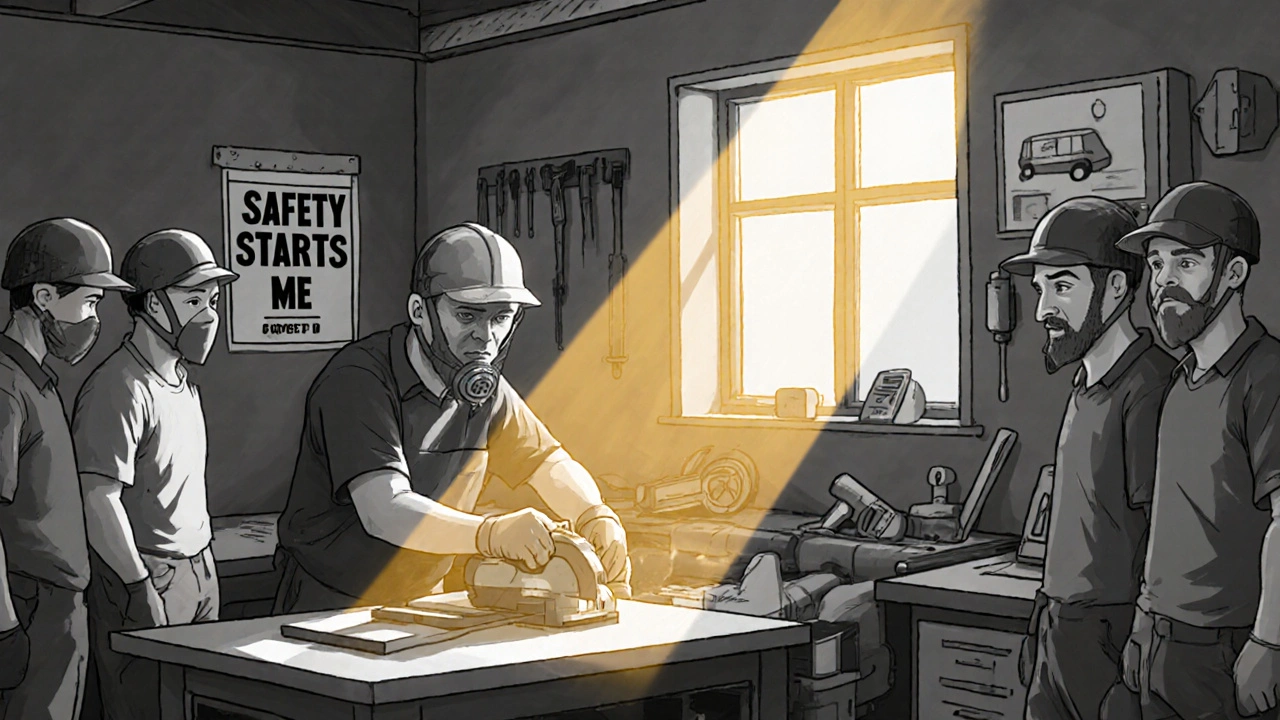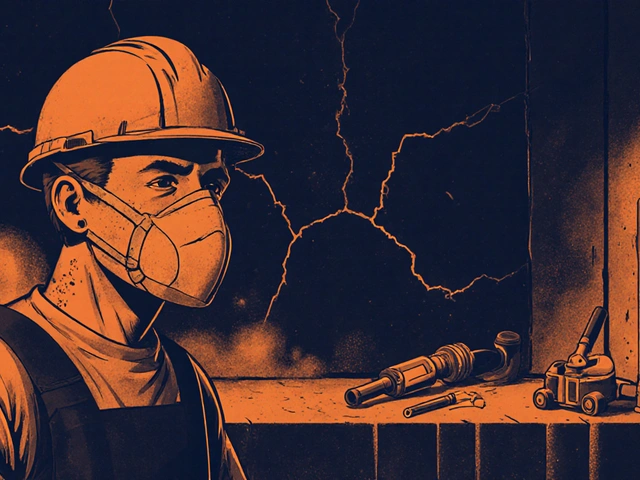
Every year, thousands of workers breathe in dust and fibers they can’t see-and pay for it with their lungs. Silicosis and asbestosis aren’t rare accidents. They’re predictable, preventable, and still happening today. In the U.S. alone, about 1,200 people die from silicosis each year. Asbestosis claims another 1,100+ lives annually. These aren’t just numbers. They’re construction workers, miners, demolition crews, and factory staff who were never given real protection.
What Silicosis and Asbestosis Actually Do to Your Lungs
Silicosis starts when you breathe in crystalline silica dust. It’s in sand, stone, concrete, and even some engineered countertops. When you cut, grind, or drill these materials, invisible particles get into your airways. Your body tries to fight them off, but over time, the dust causes scar tissue to build up. Your lungs stiffen. Breathing becomes harder. There’s no cure. Once the damage is done, it only gets worse.
Asbestosis is similar, but it comes from asbestos fibers. These were used in insulation, pipes, brake pads, and roofing materials for decades. When those materials break down, fibers float in the air. They stick in your lung tissue, triggering inflammation and scarring. The scary part? It can take 10 to 40 years for symptoms to show up. By then, it’s too late to reverse it.
Both diseases are progressive. You might feel fine for years. Then, one day, you can’t climb stairs without gasping. Or you start coughing nonstop. Doctors can’t fix the scarring. All they can do is slow it down-and that only works if you stop the exposure early.
Why These Diseases Are Still Around in 2025
If we’ve known about these dangers since the 1800s, why are people still getting sick? Because prevention isn’t just about rules-it’s about culture.
In construction, wet cutting reduces silica dust by 90%. But many crews still use dry saws because they’re faster. Workers say their bosses push them to finish jobs quickly, even if it means skipping water sprays. One Reddit user wrote: "My company got wet saws last year. But the foreman still yells at us for taking too long with water."
Asbestos is trickier. It’s still in 733,000 U.S. public buildings. When renovations happen, contractors sometimes cut corners. Workers don’t always get proper training. And even when they do, wearing a P-100 respirator in 90-degree heat is brutal. One industrial hygienist reported that respirator compliance drops to 40% in summer. People take them off. Or they modify them to make them "more comfortable." That’s not bravery-it’s desperation. And it kills.
OSHA cited over 1,000 construction companies for silica violations in 2021. Fines totaled $3.2 million. But fines don’t stop deaths. Real change needs enforcement, yes-but also buy-in from the people on the ground.
The Hierarchy of Controls: What Actually Works
Not all protection is created equal. The best way to stop these diseases isn’t by handing out masks. It’s by removing the hazard at the source.
Here’s what the experts say works, ranked from most to least effective:
- Elimination or substitution: Don’t use silica-containing materials if you can avoid them. Use alternatives like aluminum oxide abrasives instead of sandblasting.
- Engineering controls: These reduce exposure by 80-90%. Examples: local exhaust ventilation on tools, wet cutting systems, enclosed grinding stations. OSHA says ventilation needs to pull air at 100-150 feet per minute to capture dust effectively.
- Administrative controls: Limit how long someone works in dusty areas. Rotate crews. Schedule high-risk tasks for low-traffic times. This cuts exposure by 50-70%.
- PPE: Respirators are the last line of defense. N-95 masks filter 95% of particles. P-100s filter 99.97%. But they only work if they fit. And if they’re uncomfortable, people won’t wear them.
Here’s the truth: if you rely only on masks, you’re already losing. Engineering controls are the real game-changer. A $3,000 ventilation system on a grinder pays for itself in under two years by cutting workers’ comp claims and lost time.

What Workers Need to Stay Safe
Even with the best systems in place, workers need to know how to protect themselves.
- Respirators aren’t optional. If you’re working where silica or asbestos dust is possible, wear a P-100. And get fit-tested every year. OSHA requires it. But many workers skip it. A CDC report found 68% of complaints about respirators were about fit or discomfort. Don’t tape them. Don’t cut straps. If it doesn’t seal, it’s useless.
- Wash up after work. Dust on your clothes, skin, or hair can follow you home. Shower before leaving. Change clothes. Don’t take contaminated gear into your car or house.
- Speak up. If you’re not getting proper ventilation, or your mask doesn’t fit, report it. OSHA’s whistleblower protections are real. Retaliation is illegal. But many workers don’t know that. If your boss says "just deal with it," you’re being put at risk-and you have rights.
- Don’t smoke. Smoking increases your risk of developing occupational lung disease by 50-70%. If you’re exposed to dust or fibers, quitting isn’t just good for your lungs-it’s life-saving.
Monitoring: Catching Damage Before It’s Too Late
Most people don’t feel symptoms until their lungs are already badly damaged. That’s why regular health checks matter.
The American Thoracic Society recommends spirometry tests-lung function tests-for anyone exposed to respiratory hazards. Baseline testing when you start the job. Then every five years. If you have asthma or COPD, get tested annually.
Early detection doesn’t reverse scarring. But it stops further damage. If you’re pulled off dusty work early, you can slow progression by 30-50%. That’s the difference between needing oxygen at 55 or being able to walk your dog at 70.
NIOSH’s new "Prevent eTool" platform gives workers and employers free, industry-specific guides. It’s already showing a 40% drop in respiratory incidents in pilot programs. Knowledge is power-and it’s now free.

Why Small Businesses Struggle-and How to Fix It
It’s not just big companies ignoring safety. Small shops with fewer than 20 workers are the most vulnerable. In Wisconsin, 78% of small businesses had no formal respiratory protection program in 2021. Why? Cost. Training. Lack of time.
But here’s the flip side: the cost of doing nothing is higher. One case of silicosis can cost a company over $1 million in medical bills, lost productivity, and legal fees. Meanwhile, a basic wet-cutting setup costs $2,000-$5,000. That’s less than one worker’s annual salary.
Successful small businesses don’t just buy equipment-they build culture. One construction firm in Ohio reduced respiratory incidents by 65% in three years by doing one thing: supervisors wore PPE 100% of the time. No exceptions. Workers saw it. They followed. Safety became normal.
The Road Ahead: What’s Changing in 2025
There’s progress. The European Union is tightening asbestos limits by 2025. OSHA’s National Emphasis Program on silica has conducted over 1,200 inspections since 2022. Germany’s pilot programs cut new cases by 55% with mandatory health monitoring.
But new threats are emerging. Over 1,200 new chemicals hit the market every year. We don’t yet know which ones harm lungs. Wearable sensors that track real-time dust exposure are starting to appear. These could be game-changers-if they’re used properly.
The biggest barrier isn’t technology. It’s mindset. Too many employers still see safety as a cost. It’s not. It’s an investment in people. In productivity. In survival.
Workers shouldn’t have to choose between a paycheck and their lungs. We have the tools. We have the science. We just need the will.
Can you get silicosis from one-time exposure?
No, silicosis develops over years of repeated exposure. But even short bursts of high dust levels-like from sandblasting without protection-can cause acute silicosis in weeks or months. This form is rare but deadly. There’s no safe level of exposure.
Is asbestosis the same as mesothelioma?
No. Asbestosis is scarring of the lung tissue from asbestos fibers. Mesothelioma is a cancer of the lining of the lungs, heart, or abdomen. Both come from asbestos, but they’re different diseases. Mesothelioma is always fatal. Asbestosis isn’t, but it severely limits your quality of life.
Do N-95 masks protect against asbestos?
No. N-95 masks are designed for dust and pollen, not asbestos fibers. Asbestos fibers are smaller and more dangerous. Only P-100 respirators (or equivalent) provide adequate protection. OSHA requires P-100 for asbestos work.
Can you sue your employer for silicosis or asbestosis?
Yes. If your employer failed to provide proper safety measures, training, or equipment, you may have a legal claim. Workers’ compensation covers medical costs and lost wages. In some cases, you can also file a lawsuit if negligence is proven. Consult an occupational injury lawyer.
How often should respirators be fit-tested?
At least once a year, and whenever you gain or lose 20 pounds, change facial hair, or switch respirator models. OSHA requires fit testing before initial use and annually after. A poorly fitting mask gives false confidence-and zero protection.
Are there any safe levels of asbestos exposure?
No. The International Agency for Research on Cancer (IARC) classifies asbestos as a known human carcinogen with no safe exposure level. Even one fiber can theoretically cause harm over time. That’s why total avoidance is the only real safety standard.
Ryan Everhart
So we spend billions on fancy PPE while the real fix-engineering controls-gets ignored because it takes 2 weeks to install instead of 2 minutes to slap on a mask. Classic.
Alex Ramos
I work in demolition. We got wet saws last year. Foreman still yells if we take 5 extra seconds to hook up the water. P-100s? Half the crew wears them like they’re sunglasses. 😔
Mark Rutkowski
We treat lungs like disposable batteries. You run ‘em dry, you toss ‘em. But lungs don’t come with a warranty. They don’t even come with a replacement option. Just a slow, quiet death you didn’t sign up for when you took the job. And yet we call this progress?
Amie Wilde
My cousin got silicosis. Worked 8 years in stone fabrication. Boss said 'just breathe through your mouth.' He’s 42 now. On oxygen. No lawsuit. Just silence.
Alyssa Lopez
OSHA fines? Pfft. Big corps just write it off as tax deductible. We need to jail the CEOs who let this happen. No more 'oops we forgot the ventilation.' This is murder by paperwork.
Chrisna Bronkhorst
The real issue? Workers who skip PPE aren't dumb. They're trapped. 100F heat. Mask makes you pass out. Boss says 'do it or get replaced.' This isn't negligence. It's systemic coercion.
David Barry
Let’s be real. 90% of these deaths happen in small shops with 3 guys and a pickup truck. They don’t have OSHA compliance officers. They have a guy who learned how to cut concrete from YouTube. The solution isn’t more rules. It’s better tools under $500 that actually work.
Gary Hattis
In South Africa, we call this 'death by dust.' Same story. Same silence. Workers know the risks. But when your rent is due and your kid needs medicine, you don’t ask for wet saws. You ask for paychecks. Safety only matters when it’s cheap.
Erica Cruz
I’ve read this whole thing. And honestly? The only thing worse than these diseases is the tone-deaf corporate wellness fluff. 'Stay safe!' 'We care!' Meanwhile, the PPE budget got cut for the third year. Pathetic.
Esperanza Decor
I used to think PPE was enough. Then I saw a guy cough up blood after a 2-hour sandblasting shift. No mask. No water. Just grit and grit and grit. That’s when I started pushing for ventilation. Now my crew’s got 3 exhaust hoods. No one’s dead yet. That’s a win.
edgar popa
P-100s fit like a fart in a spacesuit but they save your life. Wear it. No excuses. 🙏
Eve Miller
It’s not just about equipment. It’s about accountability. Employers who knowingly expose workers to carcinogens should be charged with involuntary manslaughter. Period. No fines. No warnings. Criminal charges.
Deepa Lakshminarasimhan
They say silica is invisible. But the real invisible thing? The corporate boardrooms where executives drink champagne while workers die in silence. The same people who fund politicians who kill OSHA funding. This isn’t an accident. It’s a plan.






Write a comment